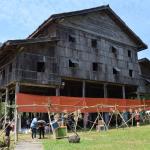When it comes to picking the most ‘health-giving’ mountain salt for your clean diet, forget about Himalayan pink salt. Here in Borneo, we have our very own salt from the central region of the island.
While on Sarawak the side of the Bornean border, salt springs are aplenty in the Kelabit Highlands, Kalimantan’s are located in the Krayan Highland.
Besides paddy planting and livestock rearing, the Lundayeh people of Krayan Highland in Kalimantan rely on salt processing from these springs to boost their income.

Salt production in Long Midang, Kalimantan
Located in the Krayan Highlands, Long Midang is the closest settlement across the Malaysian-Indonesian border from Ba Kelalan, Sarawak.
The salt production there has been going on for generations. Its production house is a humble building of wooden planks with zinc roof and cement floor.
There were two salt springs there, but both have been converted into concrete wells. Oddly, flowing next to the salt springs is a small freshwater stream.
According to local guide Alex Ballang, traditional custom requires that any visitors who enter the production house must wash their faces with the saltwater first. Plus, the saltwater is believed to be good for the skin.



Furthermore, visitors are also welcome to dip their fingers into the saltwater, especially those curious about whether the saltwater is really salty.

The Long Midang community comes together to run the salt production. According to Alex, each salt-maker household takes turns utilizing the salt spring for a continuous period of two weeks.
Inside the production house, there are two hearths made from stone and clay where the boiling of saltwater takes place.
Alex said, “They used metal drums cut lengthwise to use as pots. Since they are not stainless, they usually last up to only three months, tops.”
He assured though, that the drums are replaced before they get rusty.
Evaporating, drying and packaging the Krayan Highlands salt

In Long Midang, three metal containers were used for the salt evaporation process. Each metal container were at different stages of boiling the salt brine.
The farthest container from the hearth opening contained the freshly poured in brine, while the first container near the hearth contained the boiling brine. The middle container where the heat was the highest had the almost saturated brine.
Alex explained that the brine would be transferred from the farthest to the first, then to the middle container where the final crystallised salt was collected.

If the family members took turns continuously boiling the brine for 24 hours, they could produce up to 20kg of salt in a day.
After the crystallised salt is collected, they still need to put it under the sun to dry. The drying process usually takes up two hours depending on the weather.
Then came the packaging process. In Long Midang, the salt was packaged in plastic or the traditional way, which is with palm leaves.

The benefits of Krayan salt
Alex pointed out that the salt from Krayan highlands was rich in iodine, hence making it high in demand from the locals as well as neighbouring Malaysians.
Another benefit for the local community is that this salt production is a boost to their daily income.
Although the salt spring seems to never run dry, enabling the Long Midang community to produce salt all-year round, Alex shared that the community was slowly losing their source of firewood.
While there was a constant source of firewood in the past, it has been slowly depleting over the years.
“Perhaps, someone could come up a cost-effective alternative for the locals so that they can continuously boil the salt brine without using wood from the forest,” he said.































